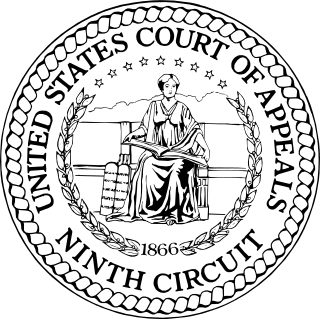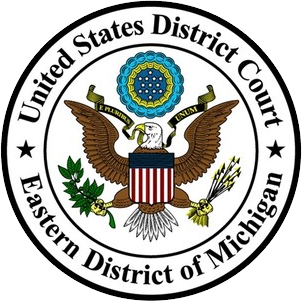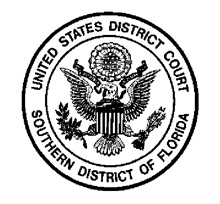
Carafano v. Metrosplash.com, Inc., 339 F.3d 1119, is an American legal case dealing with the protection provided an internet service provider under the Communications Decency Act (CDA) United States Code Title 47 section 230(c)(1). It is also known as the Star Trek actress case as the plaintiff, Chase Masterson – whose legal name is Christianne Carafano – is well known for having appeared on Star Trek: Deep Space Nine. The case demonstrated that the use of an online form with some multiple choice selections does not override the protections against liability for the actions of users or anonymous members of a Web-based service.
A declaratory judgment, also called a declaration, is the legal determination of a court that resolves legal uncertainty for the litigants. It is a form of legally binding preventive adjudication by which a party involved in an actual or possible legal matter can ask a court to conclusively rule on and affirm the rights, duties, or obligations of one or more parties in a civil dispute. The declaratory judgment is generally considered a statutory remedy and not an equitable remedy in the United States, and is thus not subject to equitable requirements, though there are analogies that can be found in the remedies granted by courts of equity. A declaratory judgment does not by itself order any action by a party, or imply damages or an injunction, although it may be accompanied by one or more other remedies.
A person having ordinary skill in the art, a person of (ordinary) skill in the art, a person skilled in the art, a skilled addressee or simply a skilled person is a legal fiction found in many patent laws throughout the world. This fictional person is considered to have the normal skills and knowledge in a particular technical field, without being a genius. He or she mainly serves as a reference for determining, or at least evaluating, whether an invention is non-obvious or not, or involves an inventive step or not. If it would have been obvious for this fictional person to come up with the invention while starting from the prior art, then the particular invention is considered not patentable.
Trespass to chattels is a tort whereby the infringing party has intentionally interfered with another person's lawful possession of a chattel. The interference can be any physical contact with the chattel in a quantifiable way, or any dispossession of the chattel. As opposed to the greater wrong of conversion, trespass to chattels is argued to be actionable per se.

The United States District Court for the Eastern District of Michigan is the Federal district court with jurisdiction over of the eastern portion of the state of Michigan. The Court is based in Detroit, with courthouses also located in Ann Arbor, Bay City, Flint, and Port Huron. The United States Court of Appeals for the Sixth Circuit has appellate jurisdiction over the court.
The inventive step and non-obviousness reflect a general patentability requirement present in most patent laws, according to which an invention should be sufficiently inventive—i.e., non-obvious—in order to be patented. In other words, "[the] nonobviousness principle asks whether the invention is an adequate distance beyond or above the state of the art".
NTP, Inc. is a Virginia based Corporation founded in 1992 by the late inventor Thomas J. Campana Jr. and Donald E. Stout. The company is widely known for licensing push email patents invented by Thomas J. Campana Jr. and Donald E. Stout to Research In Motion, the manufacturer of BlackBerry for $612.5 Million USD.
John Fitzgerald Duffy is Professor of Law at University of Virginia School of Law in Charlottesville, Virginia. He is a Legal Commentator and Author who has written numerous articles and co-authored a scholarly book on Patent Law. He previously served as law clerk to Antonin Scalia, Associate Justice of the Supreme Court of the United States, and Stephen F. Williams, Judge of the United States Court of Appeals for the District of Columbia Circuit. Between these two assignments, he served as an attorney at the Office of Legal Counsel in the United States Department of Justice. In addition to clerking for Justice Scalia, John Duffy has been very influential in regard to constitutional law and the appointment of federal judges.
KSR Int'l Co. v. Teleflex Inc., 550 U.S. 398 (2007), is a decision by the Supreme Court of the United States concerning the issue of obviousness as applied to patent claims.
Teleflex Incorporated, headquartered in Wayne, Pennsylvania, is an American provider of specialty medical devices for a range of procedures in critical care and surgery. Teleflex has annual revenues of $1.8 billion, operations in 40 countries, and more than 12,000 employees. By 2011, the company had substantially realigned to focus on its current business as a medical-device manufacturer, having undergone several years of active acquisitions and divestitures. As of 2012, the chairman and CEO of the company was Benson F. Smith. Teleflex has been associated with Irish corporate tax avoidance tools.
Anderson's-Black Rock, Inc. v. Pavement Salvage Co., 396 U.S. 57 (1969), is a 1969 decision of the United States Supreme Court on the legal standard governing the obviousness of claimed inventions. It stands for the proposition that, when old elements are combined in a way such that they do not interact in a novel, unobvious way, then the resulting combination is obvious and therefore unpatentable.
Sakraida v. Ag Pro Inc., 425 U.S. 273 (1976), was a unanimous 1976 Supreme Court decision holding a claimed invention obvious because it "simply arranges old elements with each performing the same function it had been known to perform, although perhaps producing a more striking result than in previous combinations."

AT&T Corp. v. Excel Communications, Inc., 172 F.3d 1352 was a case in which the United States Court of Appeals for the Federal Circuit reversed the decision of the United States District Court for the District of Delaware, which had granted summary judgment to Excel Communications, Inc. and decided that AT&T Corp. had failed to claim statutory subject matter with U.S. Patent No. 5,333,184 under 35 U.S.C. § 101. The United States Court of Appeals for the Federal Circuit remanded the case for further proceedings.

Phillips v. AWH Corp., 415 F.3d 1303, was a case decided by the Federal Circuit that clarified the hierarchy of evidentiary sources usable for claim construction in patent law.
For a patent to be valid in Canada, the invention claimed therein needs to be new and inventive. In patent law, these requirements are known as novelty and non-obviousness. A patent cannot in theory be granted for an invention without meeting these basic requirements or at least, if a patent which does not meet these requirements is granted, it cannot later be maintained. These requirements are borne out of a combination of statute and case law.
Mayo v. Prometheus, 566 U.S. 66 (2012), was a case decided by the Supreme Court of the United States that unanimously held that claims directed to a method of giving a drug to a patient, measuring metabolites of that drug, and with a known threshold for efficacy in mind, deciding whether to increase or decrease the dosage of the drug, were not patent-eligible subject matter. The decision was controversial, with proponents claiming it frees clinical pathologists to practice their medical discipline, and critics claiming that it destabilizes patent law and will stunt investment in the field of personalized medicine, preventing new products and services from emerging in that field.

Finjan, Inc. v. Secure Computing Corp., 626 F.3d 1197 (2010), was a patent infringement case by the United States Court of Appeals for the Federal Circuit involving "proactive scanning" technology for computer security. The Federal Circuit made a mixed decision after hearing the appeals from both sides. In terms of infringement, the Federal Circuit affirmed Secure Computing's infringement on Finjan's system and storage medium patent claims but reversed the infringement on Finjan's method claim. In terms of damage award, the Federal Circuit not only affirmed the previous $9.18 million award by the United States District Court for the District of Delaware, but also remanded for the district court to assess the extra damages between the post-judgement and pre-injunction period.

Omega World Travel, Inc. v. Mummagraphics, Inc., 469 F.3d 348, is a case in the United States Court of Appeals for the Fourth Circuit in which Mummagraphics, Inc. sued Omega World Travel, Inc. (Omega) and Cruise.com alleging that they sent 11 commercial e-mail messages in violation of the Controlling the Assault of Non-Solicited Pornography and Marketing (CAN-SPAM) Act of 2003 as well as Oklahoma state law. In the initial filing, the United States District Court for the Eastern District of Virginia had awarded summary judgment to Omega on all of Mummagraphics' claims finding that the commercial emails from Omega did not violate the CAN-SPAM Act, and that the CAN-SPAM Act preempted Oklahoma state law. The Court of Appeals affirmed.
Akamai Technologies, Inc. v. Limelight Networks, Inc., 797 F.3d 1020, is a 2015 en banc decision of the United States Court of Appeals for the Federal Circuit, on remand from a 2014 decision of the U.S. Supreme Court reversing a previous Federal Circuit decision in the case. This is the most recent in a string of decisions in the case that concern the proper legal standard for determining patent infringement liability when multiple actors are involved in carrying out the claimed infringement of a method patent and no single accused infringer has performed all of the steps. In the 2015 remand decision, the Federal Circuit expanded the scope of vicarious liability in such cases, holding that one actor could be held liable for the acts of another actor "when an alleged infringer conditions participation in an activity or receipt of a benefit upon performance of a step or steps of a patented method and establishes the manner or timing of that performance." In addition, the court held that where multiple "actors form a joint enterprise, all can be charged with the acts of the other[s], rendering each liable for the steps performed by the other[s] as if each is a single actor."






